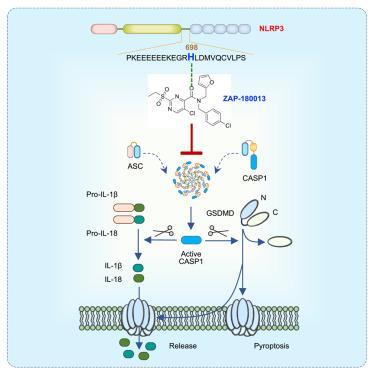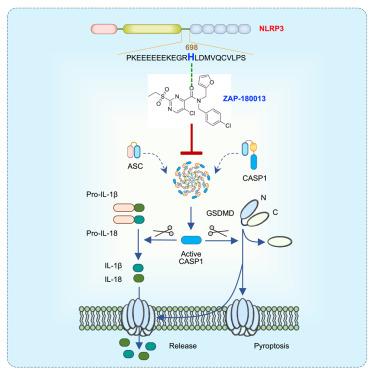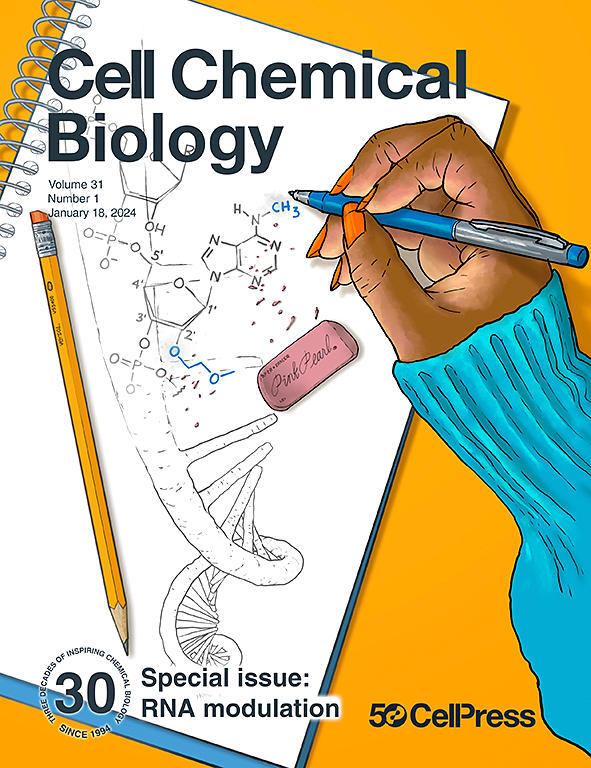一种有效的NLRP3抑制剂,对mcc950敏感和耐药炎症均有效
IF 7.2
1区 生物学
Q1 BIOCHEMISTRY & MOLECULAR BIOLOGY
引用次数: 0
摘要
核苷酸结合寡聚化结构域(NOD)样受体蛋白3 (NLRP3)炎性小体检测广谱的病原体和损伤相关分子模式(PAMPs和DAMPs),通过caspase-1激活和白细胞介素(IL)-1β/IL-18释放引发炎症反应。失调的NLRP3激活与一系列疾病有关,包括感染性疾病、自身炎症性疾病、代谢紊乱和癌症,使其成为一个有吸引力的治疗靶点。在这里,我们通过高通量化学筛选发现ZAP-180013是一种有效的、选择性的NLRP3小分子抑制剂。分子对接预测ZAP-180013与NLRP3中组氨酸698 (H698)相互作用;通过取代H698A,消除了结合和抑制活性,证实了这一点。ZAP-180013可有效抑制人髓细胞(包括携带mcc950耐药NLRP3突变的细胞)的炎性体活化。在体内,全身给药ZAP-180013可改善牛皮癣样皮肤炎症,并保护小鼠免受脂多糖(LPS)诱导的细胞因子反应。这些研究结果表明,ZAP-180013是一种有效的、选择性的NLRP3抑制剂,在mcc950敏感和耐药的炎症疾病环境中都具有翻译潜力。本文章由计算机程序翻译,如有差异,请以英文原文为准。


A potent NLRP3 inhibitor effective against both MCC950-sensitive and -resistant inflammation
The nucleotide-binding oligomerization domain (NOD)-like receptor protein 3 (NLRP3) inflammasome detects a broad spectrum of pathogen- and damage-associated molecular patterns (PAMPs and DAMPs), initiating inflammatory responses through caspase-1 activation and interleukin (IL)-1β/IL-18 release. Dysregulated NLRP3 activation is implicated in a range of diseases, including infectious diseases, autoinflammatory disorders, metabolic disorders, and cancer, making it an attractive therapeutic target. Here, we identify ZAP-180013 as a potent and selective small-molecule inhibitor of NLRP3 through high-throughput chemical screening. Molecular docking predicted that ZAP-180013 interacts with histidine 698 (H698) in NLRP3; this was validated by H698A substitution, which abolished binding and inhibitory activity. ZAP-180013 effectively inhibited inflammasome activation in human myeloid cells, including those carrying MCC950-resistant NLRP3 mutations. In vivo, systemic administration of ZAP-180013 ameliorated psoriasiform skin inflammation and protected against lipopolysaccharide (LPS)-induced cytokine responses in mice. These findings establish ZAP-180013 as a potent and selective NLRP3 inhibitor with translational potential in both MCC950-sensitive and -resistant inflammatory disease settings.
求助全文
通过发布文献求助,成功后即可免费获取论文全文。
去求助
来源期刊

Cell Chemical Biology
Biochemistry, Genetics and Molecular Biology-Molecular Medicine
CiteScore
14.70
自引率
2.30%
发文量
143
期刊介绍:
Cell Chemical Biology, a Cell Press journal established in 1994 as Chemistry & Biology, focuses on publishing crucial advances in chemical biology research with broad appeal to our diverse community, spanning basic scientists to clinicians. Pioneering investigations at the chemistry-biology interface, the journal fosters collaboration between these disciplines. We encourage submissions providing significant conceptual advancements of broad interest across chemical, biological, clinical, and related fields. Particularly sought are articles utilizing chemical tools to perturb, visualize, and measure biological systems, offering unique insights into molecular mechanisms, disease biology, and therapeutics.
 求助内容:
求助内容: 应助结果提醒方式:
应助结果提醒方式:


